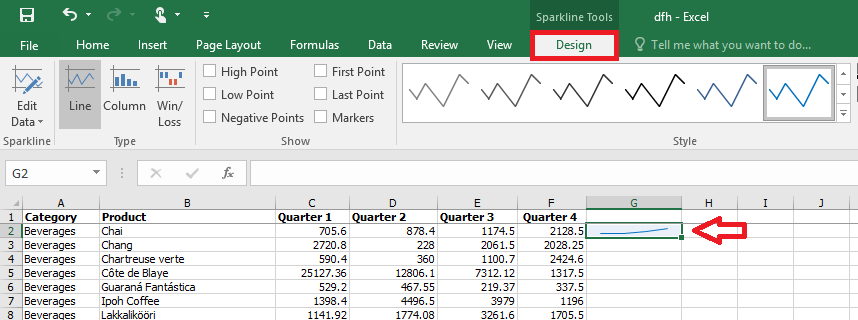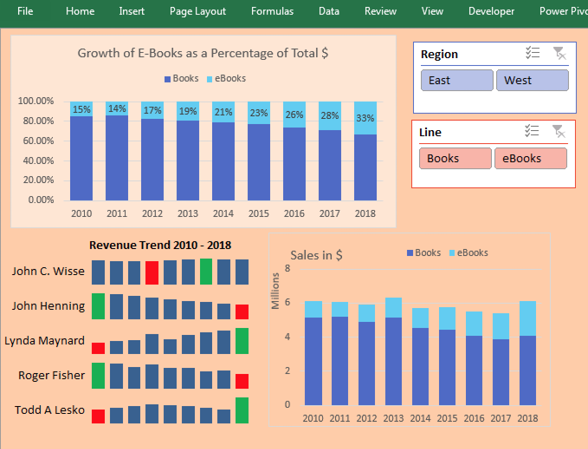

This Blog Article from Microsoft Office explains how to insert and edit sparklines. See Vertex42's original article on Sparklines from 2006. Be creative! They're easy enough to add that it's worth experimenting to see if a sparkline will help you analyze your data. There are many more applications for sparklines. That's all you need to know to get started using sparklines. Instead, once you've selected the sparkline, you'll need to go to the Design tab on the ribbon and click Clear. To delete a sparkline, you can not just select it and push the delete key. One is to mark some of the points, such as the highest and lowest values. You have several customization options here. To edit a sparkline, click on it and choose the Design tab on the ribbon. Then the range should be the same number of columns as your data). (Unless you want to chart columns instead of rows. Pick a range that is the same number of rows as your data. A Sparkline is basically a little chart displayed in a cell representing your selected data set that allows you to quickly and. Inserting a sparkline using the new Insert > Sparklines feature in Excel 2010+ is much easier. But that takes a lot of time and can be tricky to get the graphs just the way you want them. The Create Sparklines dialog box will appear, asking you to choose a location for the sparklines. One of the cool features of Excel 2010 is the addition of Sparklines. If you want to, you can make a sparkline with Insert > Chart and take the time to shrink the new chart, re-size the axes, and get rid of all labels. In the Sparklines group, choose one of the 3 types (Line, Column, or Win/Loss). Then select just the cells with temperature data, not the cells listing the months or the cities. If you want to chart the average monthly temperature in different cities, create a table of the average temperature each month for each city. To create sparklines, you start with a table of numerical data, just like you would with any other chart. Line sparklines help you see data trends and answer questions like these: How much does my data fluctuate? Does it trend upward or downward? What are the high and low points? Here is an example with temperature data for a few cities (sample data from ).Įxample of sparklines showing win/loss records. Inserting a sparkline using the new Insert > Sparklines feature in Excel 2010+ is much easier.Įxcel 2010+ provides 3 types of sparklines: Line, Column, and Win/Loss. If you want to, you can make a sparkline with Insert > Chart and take the time to shrink the new chart, re-size the axes, and get rid of all labels.


Sparklines are different from other Excel charts because they are smaller, don't have labels, and show only one line of data. Edward Tufte defines sparklines in his book, Beautiful Evidence: " Sparklines are data-intense, design-simple, word-sized graphics." Sparklines are small, simple charts that are easy to make, easy to understand, and small enough to fit in a single cell alongside your data. Now let's consider the feature in Excel known as Sparklines. Next, on the Design tab, click Column (instead of Win/Loss) to clearly see how high and low the values are.Would you rather wade through a table of data or look at charts? You'll probably say charts, maybe because they help you see data trends and interpret numbers more easily.
How to create sparklines in excel 2016 download#
Download the Excel file and select the sparklines. Win/Loss SparklinesĪ win/loss sparkline only shows whether each value is positive (win) or negative (loss). Note: now you can clearly see that the earnings of Jack are much higher. Under Vertical Axis Minimum Value Options and Vertical Axis Maximum Value Options, select Same for All Sparklines. After selecting the Line option, a Create Sparklines dialog box will appear. Click on the Insert tab, under which you need to select the Line option from the Sparklines menu appearing on the toolbar. On the Design tab, in the Group group, click Axis.ĥ. Select the empty cell where you wish to insert the line sparkline, i.e. Note: all green bars have the same height, but the maximum values (B2, E3 and F4) are different!Ĥ. On the Design tab, in the Type group, click Column. To compare sparklines, execute the following steps.Ģ. The minimum value is plotted at the bottom of the cell. The maximum value is plotted at the top of the cell. By default, each sparkline has its own vertical scale.


 0 kommentar(er)
0 kommentar(er)
